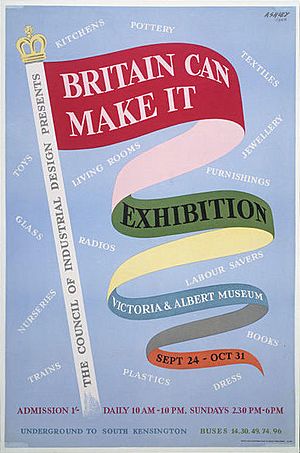Britain Can Make It facts for kids
The Britain Can Make It exhibition was a big show of new designs for everyday products. It took place in 1946 at the Victoria and Albert Museum in London. The Council of Industrial Design (which later became the Design Council) organized it. This exhibition aimed to show the world that Britain could still create amazing things after World War II.
Contents
Why the Exhibition Was Needed
Even before World War II ended, people knew Britain needed to rebuild its factories. They also needed to sell more goods to other countries. To do this, new and better designs were very important.
So, in 1944, the Council of Industrial Design was created. It was set up by the government's Board of Trade. Its main job was to help British companies improve their product designs.
The Exhibition Itself
Just one month after the war ended in September 1945, the Council announced the exhibition. They wanted to show off new designs for many different products. This became the 1946 Britain Can Make It exhibition.
James Gardner was in charge of designing the exhibition's layout. It was held from September to November at the Victoria and Albert Museum in London. This museum was chosen because many of its usual displays were still stored away safely outside London. The museum building was not damaged by bombs. It was empty and ready to host a big event to bring visitors back.
What Industrial Design Means
A key part of the exhibition was a special display called "What Industrial Design Means." This was a major project for Misha Black and his team, the Design Research Unit.
Through Black's display, called "The Birth of an Egg Cup," visitors learned about the designer's role. It showed how designers connect all the different steps of making a product. The exhibition wasn't just about showing products. It was also about convincing people that Britain needed to update its product designs. This was important for British factories to do well after the war.
The exhibition had two main audiences:
- The general public, who didn't really know what "design" meant in this way.
- Factory owners, who often still used old ways of making things.
Black's display was very eye-catching. It had a giant plaster egg, 13 feet tall, at its entrance. There was also a working machine that made 3,000 plastic egg cups every day! Visitors were very interested in seeing this machine in action.
The Design Research Unit also showed a model of a new railway coach. It was a double-decked sleeper car for third-class passengers. This was new for Britain in two ways:
- It was the first sleeper car for third-class travelers, not just first-class.
- It showed how to fit two levels into Britain's smaller train tunnels by using a special low-floor design.
How People Reacted
Many newspapers joked that the exhibition should be called "Britain Can't Have It." This was because Britain was still facing shortages after the war. The nice goods on display were mostly meant to be sold to other countries.
People's reactions were different depending on who they were:
- Design experts, like John Gloag, loved the exhibition. They praised the organizers for their smart ideas and for putting on such a big show during tough times.
- The public was also positive, but in a simpler way. They mostly just wanted to be able to buy these products in shops.
- Some factory owners were the most critical. They didn't really understand the focus on design. They just saw it as a simple shop window for their old products.
See also


